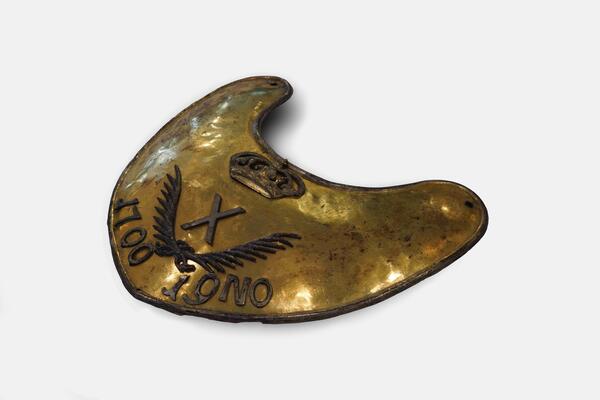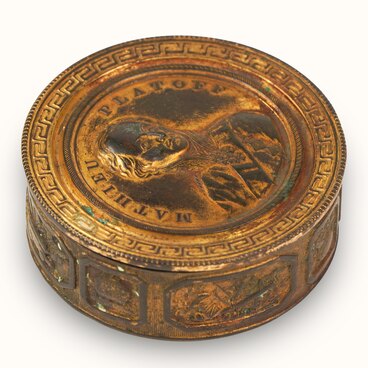Neck plates for officers were adopted in the Russian army based on European analogs in the 17th century. Their predecessors were knight’s gorgets — medallions in the form of a shield. Initially, these shields were part of the armor and protected the chest and back of the owner from the blows of cold weapons. Later they lost their practical function and served as signs of knighthood.
In the regular army, established by Peter I, there were several types of insignia for officers: a white-blue-red scarf with gold and silver tassels, a sword with a gilded hilt and a gorget with the state emblem in the center. These crescent-shaped plates were worn under the collar and fastened with loops on the buttons of the epaulette. Only artillery officers, as well as infantrymen and engineers could wear those. Cavalrymen were not entitled to them.
For the first time, Peter I granted gorgets to all the company officers of the Semyonovsky and Preobrazhensky Regiments after the battle of Narva. When the defeat became obvious, only the officers from these regiments continued to resist. Even Charles XII admired their courage, and he allowed the heroes to retreat, keeping their weapons and banners. The Narva plates were decorated with palm branches and featured the date “1700 19 No”. Such insignia existed until 1857. Since 1884, generals and field officers of these regiments had the right to wear them.
In 1732, the Izmailovsky Life Guards Regiment was established. Its officers were entitled to the plates with palm branches, but without the date of the Narva battle.
The different coatings of the elements on the plates were in strict correlation to the rank. A silvered plate with an engraving and a gilded crown (until 1715 — an overlaid one) was worn by ensigns. A plate with a silver field, a gilded crown, a silver overhead cross, the branches and a date — by sub-lieutenants.
For lieutenants, all the images gilded overlays. For captain-lieutenants, the field and the rim were gilded, the other elements were silver overlays.
On the plates for majors, the gilded overlay elements, the field and the rim were complemented by an enamel black St. Andrew’s Cross. Lieutenant colonels had all the overlaid elements of the plate covered with white enamel, while the rim and the field were gilded. Overlays of completely blue enamel were featured on colonel’s plates.
In the regular army, established by Peter I, there were several types of insignia for officers: a white-blue-red scarf with gold and silver tassels, a sword with a gilded hilt and a gorget with the state emblem in the center. These crescent-shaped plates were worn under the collar and fastened with loops on the buttons of the epaulette. Only artillery officers, as well as infantrymen and engineers could wear those. Cavalrymen were not entitled to them.
For the first time, Peter I granted gorgets to all the company officers of the Semyonovsky and Preobrazhensky Regiments after the battle of Narva. When the defeat became obvious, only the officers from these regiments continued to resist. Even Charles XII admired their courage, and he allowed the heroes to retreat, keeping their weapons and banners. The Narva plates were decorated with palm branches and featured the date “1700 19 No”. Such insignia existed until 1857. Since 1884, generals and field officers of these regiments had the right to wear them.
In 1732, the Izmailovsky Life Guards Regiment was established. Its officers were entitled to the plates with palm branches, but without the date of the Narva battle.
The different coatings of the elements on the plates were in strict correlation to the rank. A silvered plate with an engraving and a gilded crown (until 1715 — an overlaid one) was worn by ensigns. A plate with a silver field, a gilded crown, a silver overhead cross, the branches and a date — by sub-lieutenants.
For lieutenants, all the images gilded overlays. For captain-lieutenants, the field and the rim were gilded, the other elements were silver overlays.
On the plates for majors, the gilded overlay elements, the field and the rim were complemented by an enamel black St. Andrew’s Cross. Lieutenant colonels had all the overlaid elements of the plate covered with white enamel, while the rim and the field were gilded. Overlays of completely blue enamel were featured on colonel’s plates.






